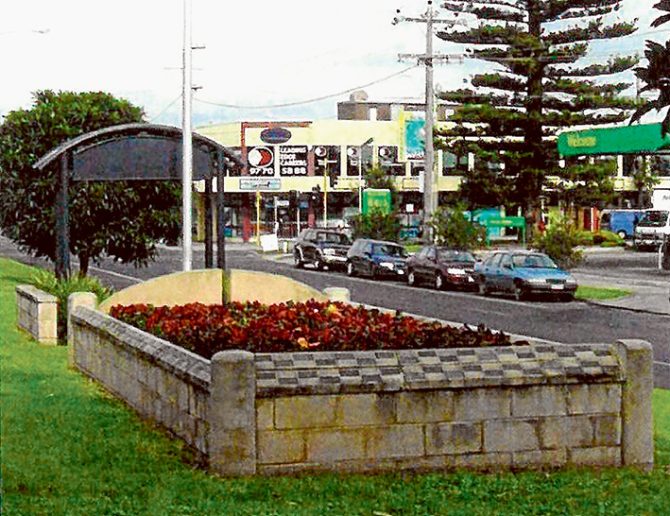Frankston’s Avenue of Honour
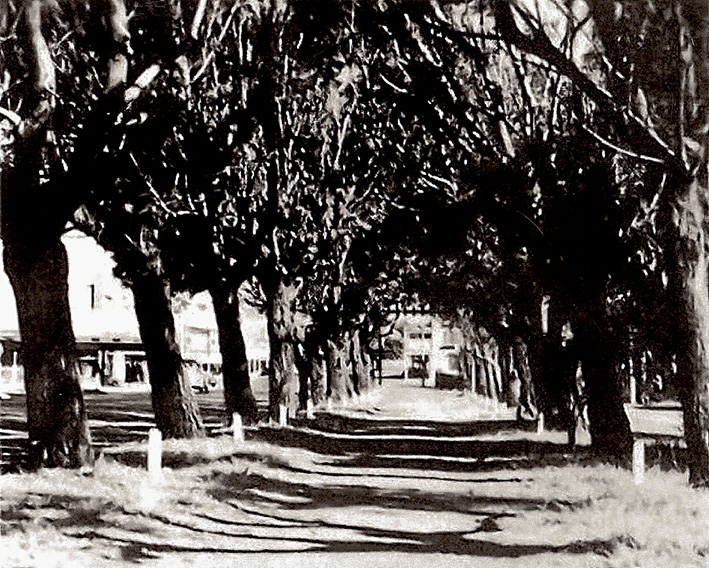
In her book “Echoes from the Front”, Val Latimer tells how as early as 1917 a committee was formed to honour all those from the Frankston District who served in World War One. This was to take the form of an Avenue of Honour along Melbourne Road, now the Nepean Highway. Trees were planted and brass plates were fixed to posts in front of each tree.
By 1957 work was underway for the construction of a new six lane highway: the trees were removed and the plates placed in storage. Of the original 216 name plates when the Avenue was established, only 153 were still in existence when the removal took place.
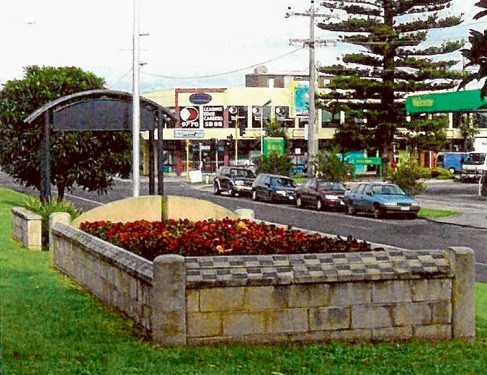
It was 1997 before the new Avenue of Honour was established, with memorial gardens placed along the centre strip of the Nepean Highway. The new memorial, however, contained 228 names and there were many other “locals” who were not listed; Mrs Latimer’s research found 50 from Frankston and local areas whose families did not respond to the call for names to be included when the Avenue was being planned.
On the other hand the legitimacy of some of the names submitted could be questioned. Were they really volunteers from the Frankston district? Several lived elsewhere but played football for Frankston, while some, such as Montague Romeo, lived in Hastings but worked in Frankston. (An article on Private Romeo’s contribution is featured elsewhere in this edition.) And that brings us to the Bartram family: all four Bartram boys enlisted and three were killed. Their brass plates are a feature of Frankston’s Avenue of Honour.
The Bartrams
The Bartram boys were born in Richmond, sons of George Andrew and Isabella (nee Shands). All four enlisted in Melbourne, presumably at the Town Hall. Isabella died in August, 1915 aged 57 and in October the following year George and two of his daughters were residing at a new address: “Clare”, in Gould Street, Frankston. So, although technically they were not Frankston citizens, when the call went out for nominations for the Avenue of Honour, the names of the four boys were submitted by the family.
As the heading indicates, 1917 was a horror year for the Bartram family as three of the boys were killed and the surviving brother was invalided home with spinal meningitis. This is the story of the sons of George and Isabella Bartram:
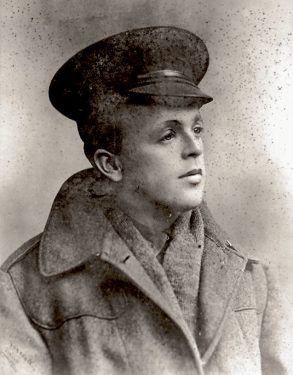
Bartram, Arnold Roy (Private). Service No. 2304: Arnold was 21, single, a shipping clerk, and living at home (9 Hull Street, Richmond) when he enlisted on 6th June, 1916. An earlier attempt to enlist had been unsuccessful on the grounds of “chest”; in the early years the army required a chest measurement of 34 inches at least. Private Bartram embarked with his brother, Cyril, at Melbourne on HMAT A67 Orsova on 1st August, 1916 with the 58th Battalion 4th Reinforcements, arriving at Portsmouth on 14th September. On 6th December he left Folkestone for France to reinforce the 60th Battalion where he was taken on strength on 5th January.
On 12th May, 1917 Private Bartram was recommended for special recognition: “At Bullecourt on the evening of 12th May, Private Arnold Roy Bartram displayed conspicuous courage and devotion to duty. Rendered valuable assistance in carrying in wounded from No Man’s Land when under very shellfire, without the least regard to his own safety. This deserves special recognition.” The recommendation was not gazetted.
On 13th May, 1917 Private Bartram, still only 21, died from a gunshot wound to the abdomen. From reports he was getting into a shell hole at Bullecourt to help a wounded man when he was shot by a sniper and died the next day. He was buried at Grevillers British Cemetery 1½ miles west of Bapaume.
On 26th May 1917 the family death notice appeared in the Argus and concluded with the inscription: “Fearless minds climb soonest unto crowns.” However, as sometimes happened in these tragic times, a mistake occurred involving Private Bartram which, for a time, would have given his family false hopes. A report in the Mornington Standard on 3rd November, 1917 stated: “It has been officially reported through the Red Cross Bureau that Private Arnold R. Bartram, “Clare”, Gould Street, Frankston (late Manager of Wine, Spirit and Tobacco Department, Mutual Store) is a POW in Germany. He was previously reported died of wounds at 29th Casualty Clearing Station on 13th May, 1917.” This report appeared shortly after the death of brother Reginald and two death notices which appeared in the Argus, only days apart, illustrate the confusion which existed. Late in October Cyril, by now back in Melbourne, inserted this notice:
BARTRAM – In proud and loving memory of my brother, Reg.,killed in action 4th October, and of Arn., killed at Bullecourt, and Ray, killed at Messines. “Three very gallant gentlemen.”
On 3rd November, the same day as the report in the Mornington Standard, the following notice was placed by “devoted sisters” Ethel and Clarice:
BARTRAM – A token of love in the memory of our dear brother, Cpl. Reginald Percy who was killed in action on 4th October, 1917, brother of Raymond Everard (killed in action 7th June, 1917) and Arnold Roy (prisoner of war).
Nobody knows how much we miss them;
How much of love, and life, and joy
Has passed on with our darling boys.
At night in a beautiful dream they will come
And visit us all at the old dear home;
Unknown to their loved ones they will stand by our side,
And whisper the words “Death cannot divide.”
In due course the report in the Mornington Standard was withdrawn and the family accepted that Arnold had been killed at Bullecourt.
Later his sister, Ethel Muriel Bartram of “Clare”, Gould Street, Frankston wrote in the Roll of Honour particulars that her brother had been a private in the Yarra Borderers Citizen Forces for three years before enlisting. Among his duties was being a Permanent Guard at the Domain.
In March, 1918 the family received Arnold’s effects which arrived on the Marathon: “ identity disc, religious medallion, stylo pen, pipe (damaged), razor, 2 badges, 6 coins, compass on wrist strap, chevron, testament, 2 wallets, photo, cards, lock of hair, charm.”
Two of Arnold’s sisters, Ethel Muriel and Clarice Edna, were named as joint beneficiaries of his will. Be that as it may his father, George, was granted a pension of one pound a fortnight as from 26th July, 1917. This was increased to two pounds a fortnight as from 1st September, 1917.
By 1922 Arnold’s father had received his medals, plus the Memorial Scroll and Memorial Plaque.
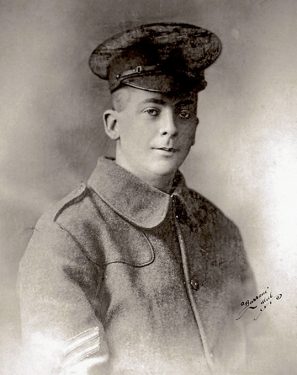
Bartram, Cyril George (Private). Service No. 2126: Cyril was the “lucky” brother – that is if you can call being invalided home with spinal meningitis as being “lucky.”
Born in Richmond, Cyril gave his father George as his next–of–kin when he enlisted on 1st May, 1916. At some point over the next few months he married Eliza MacGregor Murray and was living with his new wife in Gillies Street, Fairfield when he embarked. Cyril was 26 and a manager at the time of his enlistment.
As mentioned earlier, Cyril and Arnold embarked on HMAT A67 Orsova on 1st August, 1916 with the 58th Battalion 4th Reinforcements, disembarking at Plymouth on 14th September. Cyril’s health had deteriorated during the voyage and he was admitted to the military hospital at Devonport on his arrival.
By January, 1917 Cyril was “dangerously ill” with influenza. During convalescence he developed spinal meningitis and left for Australia on the Demosthenes on 27th July, 1917. After arriving home on 24th August, Cyril was discharged from the AIF on 26th October, 1917.
Cyril was not eligible for the 1914-15 Star Medal, nor the Victory Medal as he did not serve in a theatre of war. However he was sent the British War Medal but this was returned in May of 1923; perhaps it had been sent to the wrong address? On 17th July, 1924 it was again despatched – this time to Gillies Street, Fairfield. Cyril must have recovered reasonably well from his illness for he was elected to the Sandringham Council and became mayor in 1928. Cyril and his wife had no children but adopted the three sons of Reginald who was killed in October, 1917: Ernest George (born 1906), Reginald Arthur (1908), and William Blockley (1910). The youngest of these boys died in 1925 aged 15. Cyril’s wife, Eliza, died in 1942 aged 51 but Cyril lived until January, 1947 when he died at Caulfield, aged 57.
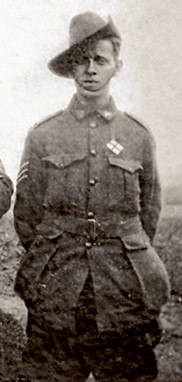
Bartram, Raymond Everard (Sergeant). Service No. 2682: Also born in Richmond and living at home with his parents in Hull Street, Ray, as he was generally known, was the first brother to enlist – on 3rd July, 1915. He had attempted to enlist earlier but had been rejected because of dental problems. He was 21, single and a machinist. On 15th September 1915 he embarked at Melbourne on SS Makarini as part of the 8th Reinforcements of the 14th Battalion.
In October, 1915 Ray was admitted to hospital in Heliopolis “dangerously ill” with appendicitis. Two months later he was again back in hospital in Luxor, again with appendicitis. In January, 1916 he was taken on strength with the 46th Battalion and was again hospitalized in Egypt with “pains in the groin.”
In March, 1916 Ray blotted his copybook for his record states:
“Crime: Pilfering goods at Abu-Sueur Railway Station of 30.3.16. Award: Awarded 14 days detention by CO 46th Battalion AIF at Serapeum 4.4.16. Forfeiture of 14 days pay.”
By 8th June Ray had joined the BEF in France. In July, 1916 the 46th Battalion occupied the Front Line at Sailly-le-Sec and the following month participated in the Battle of Pozieres. In October Raymond was admitted to hospital on several occasions with “septic hands.” His earlier misdemeanour notwithstanding, he was promoted to Corporal in December, 1916, and then to Sergeant on 18th February, 1917.
At the time of his death on 7th June, 1917 Sergeant Bartram was leading a party carrying rations to the front line on the first morning of the Messines advance. A shell exploded killing him and six others. Eye witnesses reported that he was buried at Gooseberry Farm nearby. Later his remains were re-interred at Messines Ridge British Cemetery six miles south of Ypres, Belgium.
On 6th April 1918 the Mornington Standard reported on the 7th Presentation to Frankston Volunteers: “In handing medals to Mr. Bartram, Dr. Plowman made feeling reference to the fact that of Mr. Bartram’s four boys who had volunteered, three had made the supreme sacrifice, and one had been invalided home totally unfit for further service. He (Dr. Plowman) extended heartfelt sympathy to Mr. Bartram in his great sorrow, but felt sure he would take comfort from the fact that his sons had died a glorious death, fighting nobly for Australia, and for our security and honour.” If the death notices printed here are any guide, not all members of the family shared Dr. Plowman’s euphoria. The same deep sadness was reflected in the noticed placed in the Argus on 4th July, 1917:
BARTRAM – Killed in action on 7th May. Sergt. Raymond Everard, second youngest dearly loved son of George and the late Isabella Bartram, and brother of Reg. and Cyril (both on active service) and Arnold (died of wounds) and Evelyn, Ethel and Clarice, – aged 23 years.
Our dear boys, crowned by the glimmer of glittering steel, but dimmed by the weight of tears.
Duty nobly done.
Ray Bartram obviously travelled light for in early 1918 the package of personal effects arrived via the Ulysses: “disc, photos, small book.” In August, 1918 the names of the three Bartram brothers were listed among those who were killed and the family was presented with certificates by the Shire of Frankston.
In his will Ray left his estate to sisters Ethel and Clarice, brother Arnold (who pre-deceased him) and Miss Esther Macdonald of 5 Milton Street, South Preston; quite possibly a sweetheart left behind.
Between 1921 and 1923 his father, George, received Ray’s medals, his Memorial Scroll and Memorial Plaque. George died in 1923 aged 65.
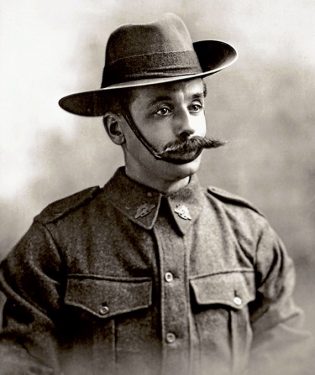
Bartram, Reginald Percy. (Lance/Corporal) Service No. 6955: Again, born in Richmond, Reginald was 34, a compositor, married with three sons and living in Florence Street, Moreland. He had married Lucy Mary Boughton in 1905. Known as Reg., he was the last of the Bartram boys to enlist, joining up on the 25th August, 1916.
Embarking at Melbourne on HMAT A20 Hororata on 23rd November, 1916 with the 8th Battalion 23rd Reinforcements, Private Bartram arrived in Plymouth on 29th January, 1917. Reg. Bartram’s life was not without complications for, during the journey to England, he fired off a letter to Base Records:
At Sea 6.12.1916 From No. 6955 Corp. R.P. Bartram 23/8 Reinforcements.
To C.O. Base Records, Melbourne.
Drawing attention to the fact that the name of Mrs. Lucy M. Bartram has been placed on my attestation papers as my next–of–kin and her address as 3 Florence Street, Moreland. As my wife has been mentally afflicted for the last seven years, and is an inmate of Mont Park Asylum for the insane, it would be manifestly absurd to forward any communication to her regarding anything that might happen to me. 3 Florence Street, Moreland is the address I gave when enlisting, for I was living there at the time. Should I be killed or meet with an injury, I would be obliged if you would forward the information to my sister, Mrs. W. Dingey, Union Street, Kew.
R.P. Barton Corporal No. 6955.
Subsequently his war records were amended to indicate that his war medals were to be sent to his son (Ernest George Barton) at the Kew address. This information notwithstanding, when Lance/ Corporal Bartram’s personal effects were despatched on the Barunga on 20th June, 1918 they were addressed to Mrs. L. Bartram, 3 Florence Street, Moreland. This was in spite of the fact that the aunt, Mrs. Dingey, had written requesting that any effects be sent to the sons at her address. The effects consisted of : “disc, belt, photo case, letters, note book, cards, book of views, badges, testament.”
As it turned out there was no dispute as to the destination of the effects as the Barunga was lost at sea. However the war pension records show that “Lucie” (Lucy) of Mont Park Asylum was granted two pounds a fortnight as from 23rd December, 1917.
The address of her sons was recorded as “Melbourne Orphan Asylum” and two of them were granted pensions: Ernest George 20 shillings a fortnight and Reginald Arthur 15 shillings a fortnight. Presumably the third son was considered too young to draw a pension! As it turned out, Lucy lived until well into her ‘80’s, dying at the Ararat Asylum in 1964.
In his will Reg. left his estate to be held in trust for his three sons until they reached the age of 21. Although the boys were subsequently adopted by Cyril and his wife, the will appointed as guardians his sister (Evelyn Constance Dingey) and her husband (William Dingey) who were permitted access to the capital for each son for “his maintenance, education or advancement in life.”
Lance/Corporal Bartram was killed in action on 4th October, 1917. From reports to the Red Cross, he was making an advance at the time of his death, having just gone over the top at Passchendaele Ridge. One eyewitness said that he saw a burial party, drawn from the 40th Battalion, burying him later that day. It was in the open, near a German pillbox, and about 1½ miles from Passchendaele Ridge.
Lance/Corporal Bartram’s remains were never found and his name is on the memorial panel 127 at the Ypres Memorial (Menin Gate) in Belgium.
With the large number of casualties it was possibly inevitable that the occasional error would occur. This happened to the last of the Bartram brothers to be listed as KIA and drew a blunt response from brother Cyril who was still convalescing and no doubt inclined to be a bit testy:
“Clare”, Frankston. 16.11.17.
Base Records, Melbourne.
I notice in Casualty List No. 352, as published in the “Herald”, “Age”, and “Argus” you have inserted my brother’s name: 6955 A/Corporal R.P. Bartram as A/Corporal R.P. Bartman. In view of the sacrifices our family has made, surely we are entitled to expect your reports to be accurate.
I will thank you to publish a correction.
Yours faithfully,
C. Bartram.
From Base Records came a chastened reply:
5th December, 1917.
Dear Sir,
In reply to your communication of 16th instant, with reference to the name of your brother, the late No. 6955, Acting Corporal R.P. Bartram, 37th Battalion having been incorrectly spelt in Casualty List 352, I have to state the error which is regretted and which escaped the detection of the checkers during a particularly busy period, is being corrected by a corrigendum attached to Casualty List 371.
Yours faithfully, Officer Base Records, Major.
To Mr. C. Bartram, “Clare”, Frankston, V.
Acknowledgement: Much of my information has come from “Echoes from the Past” by Val Latimer who has willingly helped to clarify some of the details. Copies of her book can be obtained for $25 from the Mornington Peninsula Family History Society which is located in the Recreation Centre in Tower Hill Road, Frankston. Alternatively, a copy can be posted out if a cheque for $35 is sent to the MPFHS, Post Office Box 4235, Frankston 3199. The phone number for the Society is 9783 7058.



